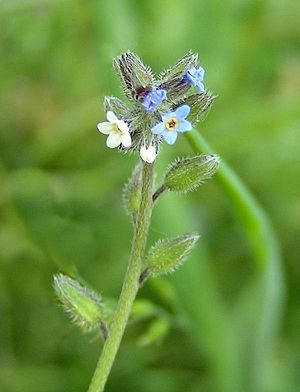Borage family facts for kids
Quick facts for kids Boraginaceae |
|
|---|---|
 |
|
| Forget-me-not (Myosotis discolor) | |
| Scientific classification | |
| Kingdom: | |
| (unranked): | |
| (unranked): | |
| (unranked): | |
| Order: |
Boraginales
|
| Family: |
Boraginaceae
|
| Subfamilies | |
|
|
The Boraginaceae is a large family of plants, often called the borage family. It includes about 2,000 different types of plants! Most of these plants are found in Europe and Asia, especially around the Mediterranean Sea.
Most plants in this family are small, soft plants called herbs. But some are woody plants, like shrubs or small trees. Many Boraginaceae plants are grown in gardens because they are beautiful. Others are used to make dyes or even as traditional medicines. Some of the most famous plants in this family are the Forget-me-not, Borage, and Heliotrope.
Contents
What Makes Boraginaceae Special?
This plant family is known for a few cool features. Many of them have flowers that grow in a special coiled shape, like a scorpion's tail, before they open up. This is called a scorpioid cyme.
Flower Power
The flowers of Boraginaceae plants usually have five petals and five stamens (the parts that make pollen). They often come in shades of blue, purple, or white. Sometimes, the flowers even change color as they get older! For example, some forget-me-nots start pink and turn blue.
Hairy Leaves
Many plants in this family have hairy leaves and stems. These hairs can feel rough to the touch. This hairiness can help protect the plant from animals that might want to eat them or from losing too much water.
Where Do They Grow?
Boraginaceae plants are found all over the world, but they are most common in places with a mild climate. You'll see a lot of them in Europe and Asia. The Mediterranean region, with its warm, dry summers and mild, wet winters, is a perfect home for many of these plants.
Different Habitats
You can find these plants growing in many different places. Some prefer sunny, open fields, while others like shadier, wooded areas. Some even grow in rocky places or near the coast. This shows how adaptable the Boraginaceae family is!
How Are Boraginaceae Used?
People use plants from the borage family in many ways. Their beauty makes them popular in gardens, but they also have other practical uses.
Garden Favorites
Many Boraginaceae plants are grown just for their looks.
- Forget-me-nots (Myosotis) are famous for their tiny, bright blue flowers. They are often planted in flower beds or pots.
- Heliotropes (Heliotropium) have lovely purple or blue flowers and a sweet, vanilla-like scent. They are popular in gardens for their fragrance.
Food and Medicine
Some plants in this family have been used by people for centuries.
- Borage (Borago officinalis) is a well-known herb. Its leaves can be eaten in salads, and its flowers are sometimes used to decorate drinks. Borage oil, made from its seeds, is also used in some health supplements.
- Comfrey (Symphytum) has been used in traditional medicine for a long time, often in creams or poultices for skin problems. However, it's important to know that some types of comfrey can be harmful if eaten.
Natural Dyes
Some Boraginaceae plants can even be used to make natural dyes. For example, the roots of certain plants in this family can produce red or purple colors. This was especially useful before synthetic dyes were invented.
Famous Members of the Family
Let's take a closer look at some of the most recognizable plants in the Boraginaceae family.
Forget-me-not
The Forget-me-not (Myosotis) is perhaps the most famous. These small plants have delicate blue, pink, or white flowers. They are often seen as symbols of remembrance and love. They grow wild in many parts of the world and are also very popular in gardens.
Borage
Borage (Borago officinalis) is an annual herb with bright blue, star-shaped flowers. It has hairy leaves and stems. It's often grown in herb gardens and is known for its cucumber-like flavor.
Heliotrope
Heliotrope (Heliotropium) plants are loved for their clusters of fragrant purple or blue flowers. The name "heliotrope" means "turning to the sun," as some varieties appear to follow the sun's movement.
Hound's Tongue
Hound's Tongue (Cynoglossum) gets its name from its long, soft leaves that look a bit like a dog's tongue. Some types are grown for their pretty flowers, while others are considered weeds.
See also
 In Spanish: Borragináceas para niños
In Spanish: Borragináceas para niños

